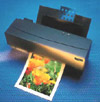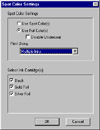Alps
MD-5000 Photographic-Quality
|
||
Click on a thumbnail to enlarge it. Use your browser's "BACK" button to return to this review when done. |
||
|
The Alps MD-5000 Photographic-Quality Color Printer is a Micro Dry
thermal resin printer capable of 600 or 2400 dots per inch printing
for both monochrome and full color images. Alps uses a thermal-resin
technology that places various-size dots onto the paper using resins
with pigments. Alps also uses Micro Dry inks, which are ribbon-style
cartridges, to apply ink to the paper. Since the inks are Alps Electric has been in business since 1976. They make floppy disk drives, keyboards, and invented the touchpad used on notebook computers. They produce a variety of electronic products from computer peripherals such as high contrast LCD panels and disk drive components, to electromechanical controls for the automotive industry, and audio and lighting control applications. Their Web site is worth checking out: http://www.alpsusa.com The Alps MD-5000 is available with either a bi-directional parallel port for Windows-based systems or a SCSI module for Macintosh OS V7.01 or later. Price: PC Printer ($599); Mac/PC Printer ($649). Optional features are: Dye Sublimation Kit ($99); USB Interface Kit for the iMac OS V8.01 and Windows ($99); and Adobe PostScript 3 with Pantone Color Matching for Macintosh ($149.99). |
||
| Serious Beginners, Intermediate, and Advanced computer users. The printer is not difficult to use but I suggest that it would be helpful to have a solid understanding and some practical experience using printers, but it is not absolutely necessary. There are a variety of ribbons, and papers settings that might seem confusing to a very beginner. Once you become familiar with the ribbons, papers, and settings, it is easy to use. I had problems with setting up the printer as I had a variety of other peripherals attached to the computer and the Alps can be finicky if you are using other printers. It doesn't like switches, prefers its own parallel port, and wants to have a LPT 1 address. If you are unfamiliar with setting up a printer, especially with bi-directional printers, or have other printers attached to your computer, you might consider getting help. There are two User Guides, one printed and the other on the CD, that come with the printer but I found them confusing. Don't let these factors deter you from purchasing the printer, though. It is well worth the few hassles you might encounter. The printer is perfect for graphic artists, professional photographers, serious hobbyists and small businesses who need the best possible color output for a variety of digital printing applications. | ||
|
||
|
Installation: I did have difficulty with the installation. Part of the problem was that I wanted to use the printer with a PC computer that probably had more peripherals, including other printers, attached to it than most of your stores have for sale. Nowadays, it is not uncommon for the average computer buff to have a variety of peripherals and printers so I thought this was a good test to see how the Alps handled the situation. I can just hear all the die-hard Mac users mumbling under their breath: "What did you expect from a PC; use a Mac." But the other printers I had attached to the computer were Hewlett Packard laser printers and Epson inkjet printers and I had no problem installing them. Well, when it came to the Alps, it was a comedy of errors. First, you need bi-directional cables and/or switches and the local store gave me the wrong cables. Then I wanted to use an internal switch to go from one printer to another but couldn't find one that would accommodate all the printers I wanted to use. I tried one external switch but wasn't sure it was bi-directional and then tried another. Still nothing would work. Again, the store wasn't sure what they had sold me. Finally I purchased another parallel port because I was told by Alps technicians that the Alps could be finicky with other printers or devices. When you install another port, the second port is assigned to LPT 2, with the first one being LPT 1 with all the other peripherals on it. Well, the Alps wanted to be on LPT 1, so all my drivers had to be uninstalled from LPT 1 and then reinstalled to LPT 2, so the Alps could be assigned to LPT 1. It finally worked. After a week of store errors, wrong switch boxes and cables, dealing with a printer that matched Greta Garbo in its "I want to be alone" stance, I was so frustrated, I didn't even test it for another few weeks. But I absolutely love the printer now and would go through the ordeal again if I had to. My advice to anyone interested in the printer is to make sure you have the right cables, switch boxes, additional ports or whatever you need before you start. And you might give the Alps technical support a call and discuss with them what your setup is and what other devices you have attached to your computer before you decide on how to install the printer. On a happy note, though, the dye sublimation upgrade was a snap to install. There is a small key you insert in the back of the printer and special drivers, paper, and ribbons are provided with the upgrade kit. Manuals: There are two manuals
that come with the printer. One is printed, the other is on the CD.
I was not overly impressed with the manuals. Computer users vary when
it comes to liking printed material. I have friends that never open
a computer book for software or hardware. On the other hand, I am a
reader and like books and user guides. With the mass marketing of printers
and the lowering of prices, something had to go, and it was the quality
of the manuals. Since you can do so much with the Alps--print with foil
and metallic colors; use white ink for printing on dark paper; print
on both sides of the paper; and print overlays, I thought the material
was not well organized nor complete enough for what the printer can
do. For instance, when printing silver and gold foil Specifications: Compared to the large and bulky inkjets and laser printers on the market, the MD-5000 is a compact printer that will not take up much room on a desktop. It is about 18.2 inches wide by 11.8 inches deep by 7.5 inches high and weighs about 11 lbs. 8oz. There is a pullout tray, which retracts when not in use, to receive the printed paper. There are no ink cartridges. The printer uses a variety of ribbon cartridges which are easily installed in the four cartridge holders at the front compartment. You can install up to 7 ribbons, depending on the type of printing you are doing, leaving one position open for cycling. There is a high quality black cartridge, as well as a basic reusable black cartridge, which can be used over and over again. There are the standard magenta, cyan, and yellow cartridges, which are not reusable; a primer ribbon cartridge that can be used to prepare many papers for printing, even standard off-the-shelf photocopy paper; and a finish cartridge for a glossy look. For dye sublimation printing, you use a different set of ribbons. There are also ribbons so you can print with metallic colors, use silver and gold foil colors, and print in white. Printing: There are a variety of
settings and dialog boxes you have to familiarize yourself with when
you use the MD-5000 printer. You have two choices for feeding the paper
into the printer: manual and automatic. All settings are found in the
Alps Properties dialog box, where there are three tabs across the top
of the screen: Document/Quality; Paper; and Image Settings. Under each
tab are other options.
How Printers Work; Advantages/Disadvantages; and Print Quality: I tested the printer against a variety of laser and inkjet printers. I printed in color, black & white, and grayscale, and I printed full color pages, used the foil colors, and spot color. The quality was as good as or even better than what was produced on either the color laser or the inkjet printers. Many people buy two or more printers it is difficult to find just one printer that prints crisp text and color graphics or photographs. The MD-5000 gives you exceptional results in both text and photographs at an affordable price. Below is a discussion of different printing technologies and their strengths and weaknesses. In determining what printer to buy, I feel it is not necessarily a decision on which is better but what is more appropriate for a persons needs, i.e., what is it going to be used for, and what can you afford.
|
||
| The Alps MD-5000 gives you a wide range of print modes that produce quality prints, provides sharp images of skin tones, black & white photos, and the fine detail of a high quality laser printer but it has a price closer to that of an inkjet. It is great for brochures, newsletters, and flyers where you want crisp text and quality graphics. The reusable black ribbon cartridge makes it economical for printing drafts. Also having the inks in separate containers saves you money. Having prints that are smear-proof, fadeproof, and water-proof is important for many users. They can be handled immediately. I did not find the MD-5000 to be overly slow for the quality of output. It is slow when you print a full color page, but all printers are rather slow when printing full color pages. I would highly recommend the Alps MD-5000 for anyone seeking affordable high quality graphic output and sharp, clean text from a single printer. | ||
|
Graphics:
Adobe Photoshop 5.0
Web Page Editor: Dreamweaver 2.0 Scanner: Hewlett Packard ScanJet 6250C Professional Series |
||








